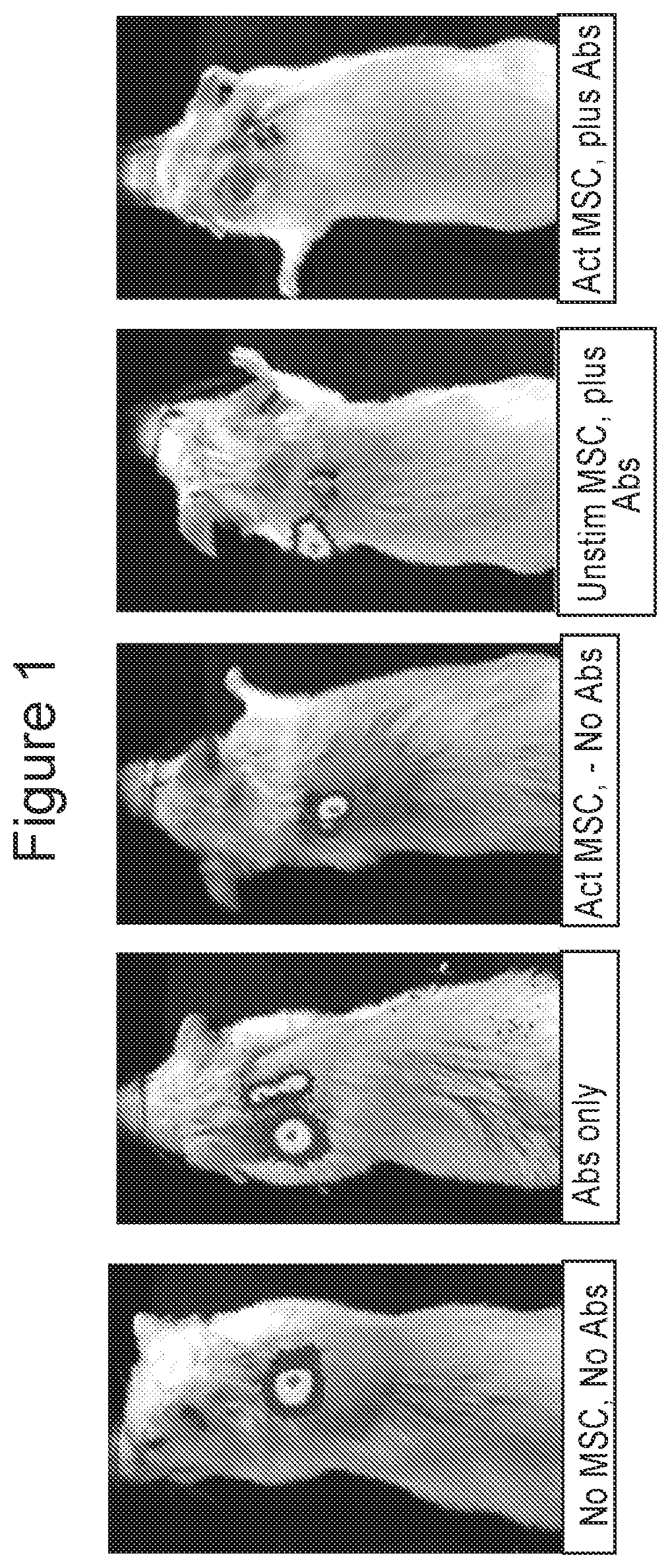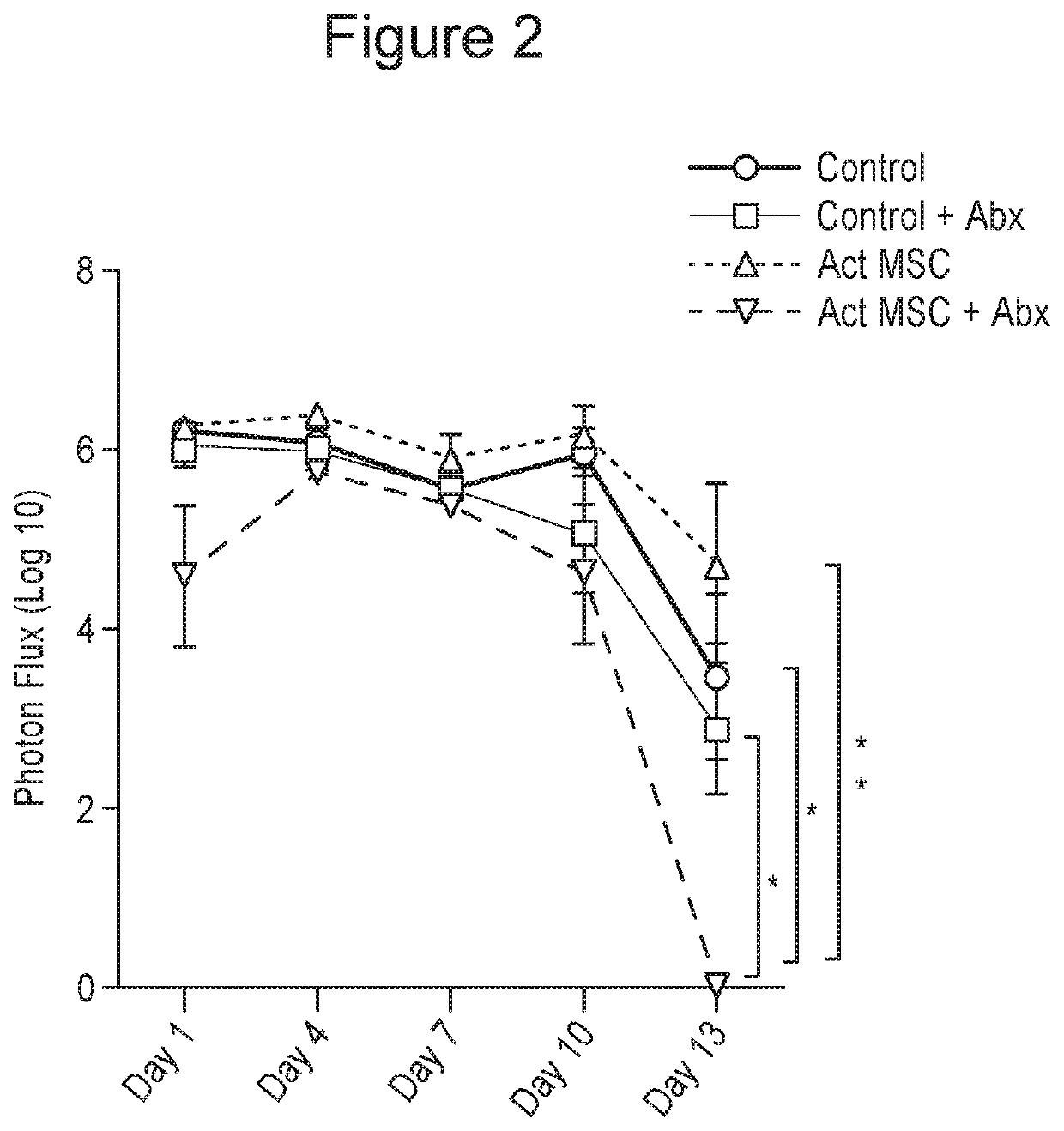Activated stem cells and systemic treatment methods for infected wounds
a technology of activated mesenchymal stem cells and systemic treatment methods, which is applied in the direction of skeletal/connective tissue cells, antibacterial agents, drug compositions, etc., to achieve the effect of increasing antimicrobial activity
- Summary
- Abstract
- Description
- Claims
- Application Information
AI Technical Summary
Benefits of technology
Problems solved by technology
Method used
Image
Examples
example 3
of Viable Bacteria at Wound Infection Sites Following i.v. Delivery of Activated MSC Combined with Antibiotic Therapy
[0173]CD-1 mice (n=5 per group) had chronic, deep S. aureus infections established using implanted, infected mesh, as described in Example 1, supra. The mice were then treated by 3 repeated i.v. injections at 3-day intervals of allogeneic adipose-derived mouse MSC. Treatment groups included untreated control animals (Ctrl), animals treated with oral amoxicllin-clavulanic acid alone (Abx), MSC alone (MSC), activated MSC alone (Act MSC), non-activated MSC plus antibiotics (MSC+Abx), or with activated MSC plus antibiotics (Act MSC+Abx), for 2 weeks. At the completion of 2 weeks of treatment, the animals were euthanized and wound tissues at the site of infection were collected and processed for quantitation of bacterial numbers of viable bacteria (colony forming units, or CFU) in the wound tissues using quantitative plating on LB agar quad plates.
[0174]Mice treated with a...
example 4
n of IV Versus Direct Wound Injection for Treatment of Chronic Wound Infections
[0176]Mice with established S. aureus wound infections as described in Example 1, supra, were treated with oral antibiotics, plus activated MSC, administered by either direct injection in the perilesional tissues (SC), or by the i.v. route. The treatments were repeated 2 additional times at 3-day intervals. On day 14, the wound tissues were collected and the bacterial burden in the tissues determined by plating and colony counts.
[0177]The results shown in FIG. 4 demonstrate that intravenous administration of MSC was found to be significantly more effective in reducing wound bacterial burden than SC administration.
example 5
f Activated MSC Administration Plus Antibiotics on Microscopic Wound Healing Features in Mouse Chronic Infection Model
[0178]Mice with S. aureus infected mesh implants were treated as described in Example 1, supra. At the completion of the study (day 21), mice were euthanized and infected wound tissues were dissected to reveal the implant site. FIG. 5 depicts a representative photomicrograph (H & E stained tissue sections, 20×) of an untreated wound (top panel) and a wound treated with activated MSC plus antibiotics (bottom panel). In the treated wound, the inflammatory cell infiltrate is significantly reduced, and the inflammation is replaced with fibroblastic healing tissues. (See FIG. 5).
PUM
 Login to View More
Login to View More Abstract
Description
Claims
Application Information
 Login to View More
Login to View More - R&D
- Intellectual Property
- Life Sciences
- Materials
- Tech Scout
- Unparalleled Data Quality
- Higher Quality Content
- 60% Fewer Hallucinations
Browse by: Latest US Patents, China's latest patents, Technical Efficacy Thesaurus, Application Domain, Technology Topic, Popular Technical Reports.
© 2025 PatSnap. All rights reserved.Legal|Privacy policy|Modern Slavery Act Transparency Statement|Sitemap|About US| Contact US: help@patsnap.com



